


xxxxxThe German Heinrich Schliemann made a vast fortune as a business man, and in 1870 was able to fulfil his ambition to prove that Homer’s city of Troy -
HEINRICH SCHLIEMANN 1822 -
Acknowledgements
Schliemann: date and artist unknown. Aeneas: detail, by the Italian artist Federico Barocci (1526-
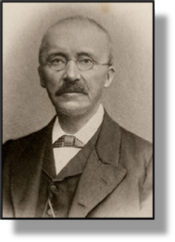 xxxxxThe German Heinrich Schliemann, a man of outstanding talent and somewhat questionable integrity, came to archaeology late in life after making his fortune as a successful business man. His discoveries at the sites of Troy in Asia Minor, and Mycenae in southern Greece threw light on the Early Bronze Age of Greek civilisation, and also gave some credence to his belief that Homer’s epic poem the Iliad, though seen as a tale of myth and legend, also had an historical basis. Though the accuracy of his research can be called into question, and others had made earlier discoveries into Aegean prehistory, he can rightly be called the “Father of Mycenaean Archaeology”.
xxxxxThe German Heinrich Schliemann, a man of outstanding talent and somewhat questionable integrity, came to archaeology late in life after making his fortune as a successful business man. His discoveries at the sites of Troy in Asia Minor, and Mycenae in southern Greece threw light on the Early Bronze Age of Greek civilisation, and also gave some credence to his belief that Homer’s epic poem the Iliad, though seen as a tale of myth and legend, also had an historical basis. Though the accuracy of his research can be called into question, and others had made earlier discoveries into Aegean prehistory, he can rightly be called the “Father of Mycenaean Archaeology”.
xxxxxSchliemann was born in the small village of Neubukow in the duchy of Mecklenburg-
xxxxxIn 1841, because of a back injury, he was obliged to leave the grocer’s shop, and he chose to go to sea as a cabin boy. Fate then took a hand. His ship was wrecked off the Dutch coast and he ended up working as a bookkeeper in an Amsterdam trading firm. Here his knowledge of languages proved his key to success. In 1846 he was sent to St Petersburg as an agent where, apart from working for his company, he made a deal of money by starting a business of his own. The early 1850s found him in California where, taking advantage of the gold rush, he set up his own bank and made another fortune buying and selling gold dust. He returned to Russia in August 1852 and, during the Crimean War, substantially increased his already sizeable bank balance by working as a military contractor.
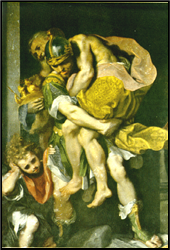
xxxxxIn 1858, with more than sufficient funds, he retired from business in order to fulfil his lifelong ambition: the discovery of Homer’s Troy. This had been his aim, he later claimed, since the age of eight when, in a book he had been given for Christmas, he saw a picture of Pius Aeneas fleeing with his father and son from the flames that were engulfing the legendary city (here illustrated). From then on he was committed to finding and proving that Troy was not a legend but an historical fact. Now, aged 36, he began to prepare for this task by spending long periods in Greece, Italy and Syria, and then making a world tour which included visits to India, China and Japan.
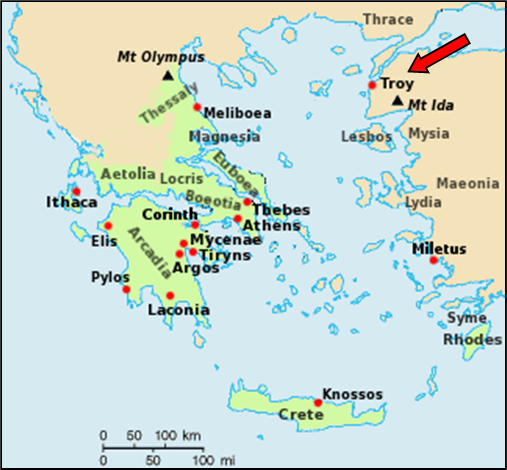 xxxxxIn 1868 he began work in earnest. He settled in Greece and began a study of the Homeric sites in his search for Troy (arrowed on map). In Asia minor there were two possible locations, but he quickly dismissed the one at Bunarbashi. It was too far from the sea and had no view of Mount Ida, and this did not fit in with Homer’s description of Troy. However, the second site, a man-
xxxxxIn 1868 he began work in earnest. He settled in Greece and began a study of the Homeric sites in his search for Troy (arrowed on map). In Asia minor there were two possible locations, but he quickly dismissed the one at Bunarbashi. It was too far from the sea and had no view of Mount Ida, and this did not fit in with Homer’s description of Troy. However, the second site, a man-
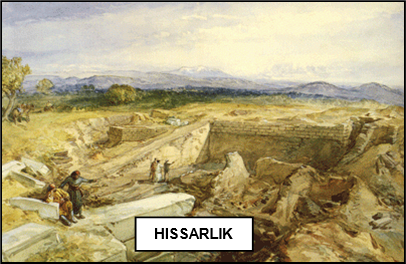 xxxxxHe began excavating at Hissarlik in 1870, assisted by his second wife, a young Greek woman named Sophia, and working in partnership with Calvert, who owned half the mound. By 1873, using a large shovel rather than a small trowel, they had dug a shaft over 50 feet deep and discovered the remains of no less than nine “cities”, one built upon the other. Schliemann discarded the last, earliest one because it appeared to have been destroyed by an earthquake (Troy was destroyed by fire) but chose -
xxxxxHe began excavating at Hissarlik in 1870, assisted by his second wife, a young Greek woman named Sophia, and working in partnership with Calvert, who owned half the mound. By 1873, using a large shovel rather than a small trowel, they had dug a shaft over 50 feet deep and discovered the remains of no less than nine “cities”, one built upon the other. Schliemann discarded the last, earliest one because it appeared to have been destroyed by an earthquake (Troy was destroyed by fire) but chose -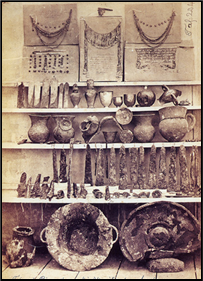 case the Greeks captured the city, he then searched for and indeed found a horde of gold jewellery which, surprisingly enough, had not been plundered. He named this “Priam’s Treasure” (a somewhat dubious assumption) and managed to smuggle most of it out of Turkey (part illustrated here). The Ottoman government, getting wind of this, imposed a heavy fine upon him, and from then on kept a closer eye upon his future excavation work, carried out in 1876 and 1878-
case the Greeks captured the city, he then searched for and indeed found a horde of gold jewellery which, surprisingly enough, had not been plundered. He named this “Priam’s Treasure” (a somewhat dubious assumption) and managed to smuggle most of it out of Turkey (part illustrated here). The Ottoman government, getting wind of this, imposed a heavy fine upon him, and from then on kept a closer eye upon his future excavation work, carried out in 1876 and 1878-
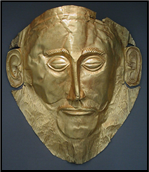
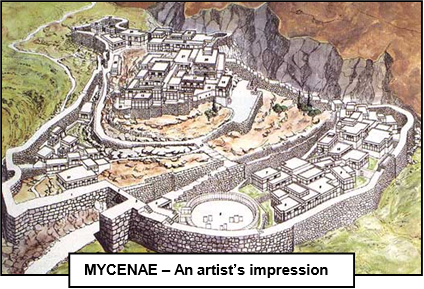 xxxxxInx1876 Schliemann turned his attention to Mycenae, the legendary home of Agamemnon, the Greek leader in the Trojan War. There, inside the citadel’s walls, he found a circle of five shaft graves containing 16 bodies together with a large number of gold, silver, bronze and ivory objects, and a variety of weaponry, such as rapiers and short swords. And among the grave goods were three death masks, one of which, Schliemann declared -
xxxxxInx1876 Schliemann turned his attention to Mycenae, the legendary home of Agamemnon, the Greek leader in the Trojan War. There, inside the citadel’s walls, he found a circle of five shaft graves containing 16 bodies together with a large number of gold, silver, bronze and ivory objects, and a variety of weaponry, such as rapiers and short swords. And among the grave goods were three death masks, one of which, Schliemann declared -
xxxxxIn his last two seasons in 1882-
xxxxxSchliemann’s findings both at Troy and Mycenae were substantial, but they were seriously flawed timewise. The items of treasure alleged to have been discovered at Troy were dated well over a thousand years before Homer’s Trojan War, and the artefact unearthed at Mycenae, including the famous death mask, belonged to a period some three hundred years before the time of Agamemnon. Furthermore, his known tendency to be economical with the truth, both in his private life and his dealings with the Ottoman government, cast some doubt upon his motives and judgment in the field of archaeology. His declared aim to “establish an historical fact”, was laudable, but with it came a temptation to make his findings conveniently fit his preconceived and passionately held beliefs. Some archaeologists have even gone so far as to suggest that he fabricated some of the evidence, but that is purely conjecture.
xxxxxNevertheless, Schliemann’s immense contribution to Aegean prehistory in particular and to the study of archaeology in general must be recognised. Firstly, he discovered the remains of Greek civilisation in the Early Bronze Age, and paved the way for an extension of this knowledge, accomplished on the island of Crete, as we shall see, by the English archaeologist Arthur Evans in 1900 (Vc). Secondly, he provided to a large extent the strong possibility -
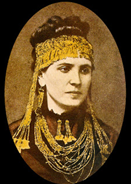 xxxxxIncidentally, Schliemann managed to smuggle out his so-
xxxxxIncidentally, Schliemann managed to smuggle out his so-
xxxxx…… After a great deal of research, Dorpfeld eventually came to the conclusion that the ancient city of Troy was at level VI (Schlieman had excavated level II), but a later study by the American archaeologist Carl Blegen, carried out in the 1930s, now suggests that it was more likely on level VII! ……

 xxxxx…… While excavating at Hissarlik, Schliemann uncovered a number of crooked crosses or “swastikas” -
xxxxx…… While excavating at Hissarlik, Schliemann uncovered a number of crooked crosses or “swastikas” -
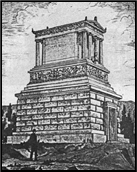
xxxxx…… Following his death, Schliemann’s body was taken to Proto Nekrotafio in central Athens and interred in a mausoleum he had had constructed. It is built in the style of an ancient Greek temple, and the frieze surrounding the building shows him working at Mycenae and other sites. The front wall bears the inscription: For the Hero Schliemann.
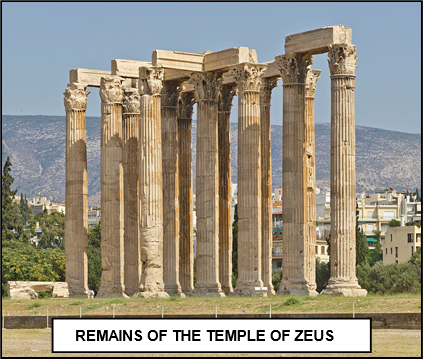 xxxxxAnother important excavation at this time, and one in which Wilhelm Dorpfeld played a part, was conducted in Olympia, the site of the ancient Olympic Games, from 1875 to 1881. The central section of the sanctuary was uncovered, including the Temples of Zeus and Hera, and some 14,000 objects were discovered. Among these were the sculptures Nike (or “Winged Victory”) by Paeonius, c420 BC, and Hermes with the Infant Dionysus by Praxiteles, c350 BC
xxxxxAnother important excavation at this time, and one in which Wilhelm Dorpfeld played a part, was conducted in Olympia, the site of the ancient Olympic Games, from 1875 to 1881. The central section of the sanctuary was uncovered, including the Temples of Zeus and Hera, and some 14,000 objects were discovered. Among these were the sculptures Nike (or “Winged Victory”) by Paeonius, c420 BC, and Hermes with the Infant Dionysus by Praxiteles, c350 BC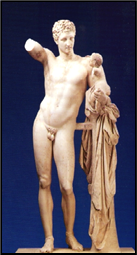 (illustrated), the sculptor who, by his Aphrodite of Cnidus of the same period, is credited with starting the tradition of the life-
(illustrated), the sculptor who, by his Aphrodite of Cnidus of the same period, is credited with starting the tradition of the life-
Vb-


